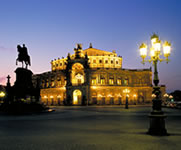Work began on the Rhododendron Park in Bremen more than 60 years ago. Today the 46-hectare park presents an amazing collection of rhododendrons and azaleas with the botanical garden right at its heart. The garden is a nature discovery centre, combining nature and culture and illustrating the relationship between people and plants, with an abundance of native plants and ones from other continents demonstrate the diversity of the earth's flora. A sun dial by the sculptor August Tölken can be found among the plants.
» www.botanika.net
A verdant paradise in the heart of Frankfurt with plants from all corners of the earth, at 26 hectares one of the largest of its kind in Germany. Founded in 1868 by the market gardener and landscape designer Heinrich Siesmeyer and opened in 1871, the display garden features a variety of themed gardens and numerous greenhouses set between the pathways and the lawns with their deck chairs. In addition to the lush plant life, Palmengarten offers themed exhibitions throughout the year. Guided tours are available for individuals and groups.
» www.palmengarten-frankfurt.de
The botanical garden, created between 1897 and 1910 and covering an area of 43 hectares, boasts around 22,000 different plant species, making it one of the largest and most important botanical gardens in the world. It also includes the Botanical Museum which has models of flowers and vegetation, ancient Egyptian burial objects, etc. The botanical garden's cathedral-like greenhouses contain some of Germany's largest collections. The 25-metre-high tropical house is the tallest greenhouse in the world. The giant Victoria water lilies are also well worth admiring. Disabled access. Guided tours on request.
» www.botanischer-garten-berlin.de
Munich's botanical garden was founded in 1809, the first of its kind. It now stretches over 22 hectares, welcomes more than half a million visitors a year and is one of the most important botanical gardens in the world. More than 14,000 plant species are cultivated here. The collections comprise plants from humid tropical regions, subtropical mountain forests and hot deserts, all growing in greenhouses covering a total area of more than 4,500m˛. The Schmuckhof garden, the rhododendron grove, the arboretum and the alpine garden are also worth a visit. Together with the special exhibitions, the garden itself is popular all year round. Accessible for wheelchair users. Guided tours on request.
» www.botanik.biologie.uni-muenchen.de
Sangerhausen is home to the largest and most diverse collection of roses in the world. The thirteen-hectare park features approximately 7,000 different types of rose. The various rose species, dating from ancient times through to modern day, are beautifully arranged in the enchanting rose garden, founded in 1903. Even exotic varieties such as the black rose or green rose can be found here, and around 300 rare species of trees and shrubs provide the backdrop for an amazing array of fragrances and colours. The rose information centre offers visitors to the rosarium a diverse range of educational services, including different seminars and presentations about the world of roses. Open May to October.
» www.rosarium.de
Opened in 1985, the Bonsai Museum in Heidelberg is one of a kind. Over many years, Paul Lesniewicz, founder and creator of the museum, has collected rare, extraordinary, beautiful and very old bonsai trees from all over the world and displays them here. The museum contains 80-100 examples of the small trees, often only a few centimetres high, including coniferous and deciduous trees, outdoor and indoor plants from all over the world. Visitors can see unusual specimens, trees and tree groups that are almost 100 years old, as well as miniature versions of rupicolous, forest and individual trees from different countries. The art of bonsai trimming makes an impressive feature of the museum and a video helps explain the details. Many great bonsai masters have visited this museum. Visitors can purchase their favourite bonsai from the adjacent Bonsai Centre.
» www.bonsai-centrum.de
The Italian-style terraced garden of the Cistercian abbey founded in 1123 lies on the south-facing side of the Kamp hills. Its main distinguishing feature is the imposing entrance area; an arbour more than 60 metres long and overgrown with wisteria leads over a modern steel construction from the abbey square to the upper terrace. From here there is a view of the whole garden and its baroque structures. Borders containing old species of rose underplanted with herbs and shrubs welcome visitors with a delightful fragrance. The terraces are also planted alternately with conical trees, creating a cascading effect down the slope. Open all year round until dusk.
» www.kamp-lintfort.de
The European Museum for Garden Art was opened in the east wing of Benrath Palace in Düsseldorf in 2002. The palace and grounds together create a work of art, with aspects of the park relating directly to the central rooms of the palace – the reflecting pond to the domed hall, the English and French gardens to the private rooms of the royal couple. There is also a wonderful kitchen garden in front of the orangery. An exhibition space of 2,000m˛ presents sculptures, paintings, prints and drawings, porcelain, books and models. The exhibits range from the villas and the locus amoenus of Antiquity to the Italian Renaissance, from baroque representation to the less formal English garden. Open all year round, closed on Mondays. Guided tours on request.
» www.schloss-benrath.de



